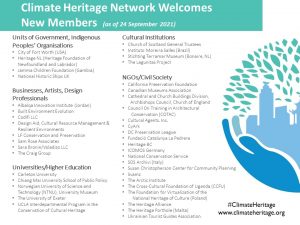CCFU joins the Climate Heritage Network
We are proud to announce that we have joined the Climate Heritage Network, which focuses on mobilising arts, culture and heritage for climate action.
As part of the 41 newest members of the Network, we are looking forward to learning from other members of the network to enrich our work as we mitigate the impact of climate change on Uganda’s heritage.
It is our hope that we shall collaborate on solutions that are driven by culture to promote climate change resilience in the world.

CCFU’s work with climate change and heritage resources.
Since last year, CCFU working in partnership with the International National Trusts Organisation (INTO) has been implementing a project titled “Melting snow and rivers in flood; mitigating the impact of a warming climate on Uganda’s heritage” aimed at safeguarding important cultural heritage elements of the people of Uganda against floods.
The receding snow on the Rwenzori mountains world heritage site, coupled with the persisting presence of the rainfall belt over the East Africa region associated with prevailing high-pressure region over the Indian Ocean and influx of moisture-laden winds from the Atlantic Ocean and the Congo Forests, has resulted in the flooding of rivers such as Nyamwamba, Mobuku, Lhuburiba, Nyamugasani and Sebwe) that burst their banks affecting cultural heritage sites in Rwenzori region. Also, a recent study reveals that water level in Lake Victoria, which is the main source of water for River Nile, has overtaken its normal long-term average and will continue to rise for the next ten years. This has left the area around Pakwach bridge flooding, with Wang-Lei cultural heritage site, which is significant for the Luo migration as the place where Gipir (Nyipir) and Labongo (Nyabongo) separated, under threat of being washed away or submerged by the water.
Hence, the project documented threatened heritage, including at least 30 expressions of the Alur (related with Wang-Lei) and the Bakonzo – with mapping and marking 9 threatened Bakonzo heritage sites. The findings were registered with the Ugandan inventory of Intangible Cultural Heritage (ICH), managed by the Ministry of Gender, Labour and Social Development.
There were also physical interventions at all the sites. At Wang-Lei, a 40m-gabion cage retaining wall was built and an information board installed. This is on top of erecting signposts at Wang-Lei (by the roadside) and the 9 sites in Rwenzori. The project also enhanced the capacity of the site caretakers and owners, and developed management plans for all the sites as a way of ensuring their sustainable management.


